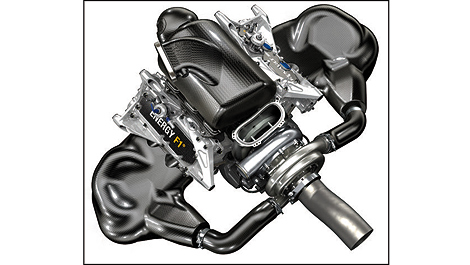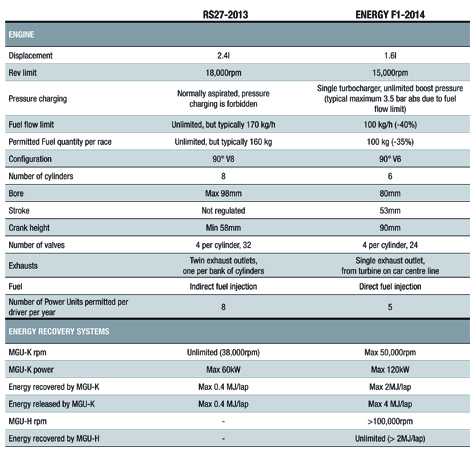Jun
28th
Stay connected Subscribe to our RSS feed
In 2014 Formula 1 will enter a new era. The most significant technical change to hit the sport in more than two decades is introduced with the switch from V8 to V6 turbo engines.
The revolution is such that experts no longer talk about an engine but rather a power unit.
Engine regulations form the major part of the coming revolution, with the introduction of a new generation of Power Units that combine a 1.6-litre V6 turbocharged engine with energy recovery systems that will dramatically increase efficiency by harvesting energy dissipated as heat in the exhaust or brakes.
The maximum power of the new Power Unit will exceed the output of current V8 F1 engines however fuel efficiency will be radically improved. With only 100kg permitted for the race, the new units will use 35% less fuel than their predecessors.
The rules for 2014
• 1.6L direct injection turbo V6
• Unique pressure charging architecture: single turbine and compressor (plus E-motor allowed)
• 5 Power Units per driver per season in 2014, reducing to 4 in subsequent years
Strong focus on improved vehicle fuel efficiency / reduced fuel consumption:
• Fuel quantity for the race limited to 100 kg initially (-35% from now - currently unlimited)
• Fuel mass flow rate limited to 100 kg/hr max - currently unlimited
• Potent Energy Recovery Systems (ERS) are allowed
The chart below illustrates the basic technical differences between the current V8 engines and next year's V6 power units.
The revolution is such that experts no longer talk about an engine but rather a power unit.
Engine regulations form the major part of the coming revolution, with the introduction of a new generation of Power Units that combine a 1.6-litre V6 turbocharged engine with energy recovery systems that will dramatically increase efficiency by harvesting energy dissipated as heat in the exhaust or brakes.
 |
| Photo: Renault Sport F1 |
The maximum power of the new Power Unit will exceed the output of current V8 F1 engines however fuel efficiency will be radically improved. With only 100kg permitted for the race, the new units will use 35% less fuel than their predecessors.
The rules for 2014
• 1.6L direct injection turbo V6
• Unique pressure charging architecture: single turbine and compressor (plus E-motor allowed)
• 5 Power Units per driver per season in 2014, reducing to 4 in subsequent years
Strong focus on improved vehicle fuel efficiency / reduced fuel consumption:
• Fuel quantity for the race limited to 100 kg initially (-35% from now - currently unlimited)
• Fuel mass flow rate limited to 100 kg/hr max - currently unlimited
• Potent Energy Recovery Systems (ERS) are allowed
The chart below illustrates the basic technical differences between the current V8 engines and next year's V6 power units.
 |
| Chart: Renault Sport F1 |
 The latest auto news, reviews, prices, product and vehicle releases.
The latest auto news, reviews, prices, product and vehicle releases.